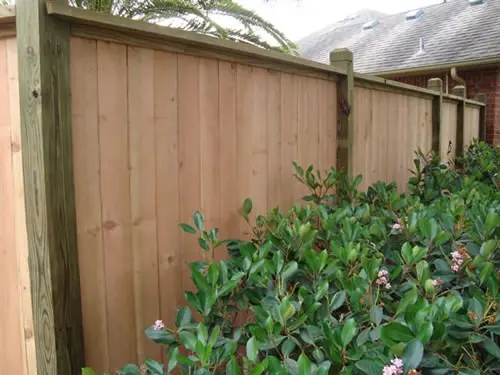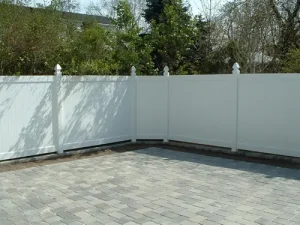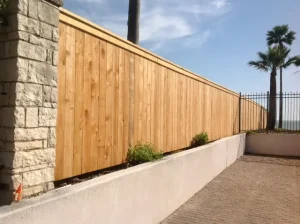![The Great Fence Debate Wood Versus Vinyl [How to Choose]](https://www.dcfence.com/wp-content/uploads/2024/04/The-Great-Fence-Debate-Wood-Versus-Vinyl-How-to-Choose-300x157.webp)
The Great Fence Debate: Wood Versus Vinyl [How to Choose?]
When it comes to enhancing the privacy, security, and aesthetic appeal of your home, few elements play as pivotal a role as your choice of

Wood fences are like the unsung heroes of outdoor spaces. They do so much more than just define property boundaries – they elevate the whole vibe! With their timeless charm and versatility, they bring both practicality and visual appeal to residential and commercial landscaping.
In this article, we’ll dive into why wood fences are a big deal when it comes to setting clear boundaries and adding that extra charm to your outdoor environment. Whether you want privacy or simply want to beautify your space, wood fences are the way to go. They bring together functionality and aesthetics in a way that lasts.
Wood fences are a top choice for property owners, and it’s easy to see why! Let’s dive into the benefits:
When you invest in a well-maintained wood fence made from quality materials, it can withstand all kinds of weather and last for years. That means you get a cost-effective option that stands the test of time.
One thing you can’t deny about wood fences is their timeless appeal. With the natural texture and color variations, they add a touch of elegance and coziness to any property. It’s all about that inviting curb appeal!
The best part? Wood fences can be customized to suit any style you fancy. From charming picket fences to intricate lattice designs, you have the freedom to match your personal taste and elevate your property’s aesthetics.
It’s not just about looks and durability – wood is also an eco-friendly choice. With its renewable and biodegradable nature, wood fences often come from responsibly managed forests. Plus, when their lifecycle ends, they can be recycled or disposed of without harming the environment.
So, if you’re looking for a durable, visually pleasing, and environmentally conscious fencing option, wood fences have got you covered!
Before choosing a wood fence for your property, consider a few important factors. First, determine your spending limit for materials, labor, and maintenance. Different wood types and fence designs come with varying price tags, so choose something within your budget.
Wood fences are durable but require regular upkeep. This includes staining, sealing, and monitoring for weather damage or pests. Consider the time and effort you can dedicate to maintenance.
Furthermore, assess your local weather patterns as they impact your fence’s durability. Humid areas may require more maintenance to prevent moisture issues, while dry climates necessitate protection from excessive sun exposure.
Lastly, determine your goals for the fence—privacy, security, or decoration. Different designs and heights cater to specific needs. For instance, a tall, solid wood fence offers privacy, while a picket fence provides a more open and decorative feel.
By considering these factors, you can find the perfect wood fence that aligns with your budget, maintenance abilities, climate, and goals. This way, your fence will not only look great but also serve its purpose effectively.
Wooden fences offer styles to choose from, including classic picket fences, sleek horizontal slats, and overlapping boards for privacy. Each design has its own spacing, height, and appearance.
These fences serve multiple purposes, enhancing curb appeal and providing privacy, security, and a timeless, natural look that complements any architectural style.
Wood fencing can be customized to fit your preferences and budget, and they are also eco-friendly. Easily stain or paint them to match your taste if you want to switch things up.
Regular maintenance, like staining, is important to protect your wood picket fence from the elements. Without care, wood can be susceptible to pests and rot. Keep in mind that certain wood types may be pricier than alternatives.
Post and rail fences are a classic and rustic style of fencing. They consist of horizontal rails attached to vertical posts, exuding a timeless charm often found in rural or farm areas.
These fences have different variations like two-rail, three-rail, and four-rail designs. They serve various purposes such as marking property boundaries, enclosing livestock pastures, or adding a rustic touch to landscapes.
One great thing about post and rail fences is their cost-effectiveness and easy installation. Their open design creates a sense of spaciousness.
However, it’s important to note that they may not offer much privacy or security. Regular maintenance is necessary to keep them looking good and protected from the weather. They might not be the best choice for suburban settings.
Split rail fences have a rustic charm that takes you back to simpler times in American history. There are two main variations: two-rail and three-rail designs.
Two-rail fences have two horizontal rails between the posts, while three-rail designs offer added support. These fences are versatile, serving as property boundaries, garden enclosures, or rustic landscaping features.
When considering a split rail fence, think about enclosure, local regulations, and achieving the desired rustic ambiance.
A lattice fence can be pretty cool because they have these fancy patterns with crisscrossed or diagonal slats. It’s like having a fence that’s both open and captivating at the same time. And the best part is, these patterns add a touch of elegance and uniqueness to your outdoor spaces.
While a lattice fence gives you some visibility, it also gives you privacy. It’s like having a barrier that still lets air and natural light come through.
Plus, those intricate designs make your garden, climbing plants, or outdoor living areas look super attractive.
To keep your lattice fences looking beautiful, give them a regular cleaning and maybe a little sealing or painting from time to time. And when it comes to design ideas, choose whatever suits your style and the vibe you want.
Board-on-board fences have a sleek and modern appearance, thanks to overlapping vertical boards on both sides.
These fences are constructed with precision, attaching sturdy vertical boards to horizontal rails. High-quality materials like cedar or redwood are used to ensure long-lasting quality.
You’ll also have plenty of options to customize your fence. From different top designs to the ability to adjust the height and appearance, homeowners can tailor it to their preferences and needs.
Shadow box fences are a great choice if you want privacy without feeling closed off. They have staggered vertical boards on both sides that allow airflow and bring in some natural light. You can customize them by choosing the height and color that suits your style.
One of the pros of these fences is that they strike a nice balance between privacy and openness, while also adding curb appeal to your property. However, it’s important to note that they may not be as secure as solid fences and will require occasional cleaning.
These fences have a sleek and modern look with horizontal boards attached to posts, giving them a contemporary and minimalist vibe.
Horizontal slatted fences are made from wood, composite, or metal and you can install them by attaching the slats to a sturdy frame.
The spacing between the slats can be customized, so you can choose the right balance of privacy and airflow.
When it comes to maintenance, it depends on the material you choose. Also, consider factors like slat spacing, height, color, and how the fence integrates with your landscaping for a visually appealing touch.
Zen-inspired outdoor designs draw from Japanese Zen philosophy, emphasizing simplicity and harmony with nature. Embrace the cultural significance and reflect Zen principles of balance, tranquility, and mindfulness.
Elements like Zen gardens, bamboo, stone pathways, and minimalist decor create a peaceful ambiance. Common material choices include bamboo, natural stones, wood, and gravel. Precision and minimalism are key in construction, carefully selecting each element for tranquility.
You can achieve the desired Zen ambiance by selecting balance-promoting elements, arranging rocks, plants, and water features, and maintaining a clutter-free and serene environment.
Cedar fences are great because they naturally resist decay and bugs, thanks to the oils and compounds in the wood. This means they last a long time, even in tough weather. Plus, there are different styles to choose from, like picket or privacy designs.
You can even give it a stained look or let it age naturally to a silvery-gray color, which shows off the beautiful grain and color variations of cedar.
Just remember to regularly stain or seal it, check for any damage, and clear away debris to keep your cedar fence looking good for years to come!
Redwood fences come in a range of beautiful hues, from deep reds to pinkish-browns. But it’s not just about looks! Redwood has natural resistance to insects and rot, thanks to its high tannin and oil content.
You’ll find various designs to choose from, including privacy, picket, and lattice styles. This means you can customize your redwood fence while still appreciating the wood’s natural beauty and durability.
Of course, it’s important to keep sustainability in mind when sourcing redwood. And don’t forget routine maintenance, like staining or sealing, regular inspections for damage, and ensuring proper drainage. By doing so, you’ll preserve the longevity and allure of your redwood fence.
Tropical hardwoods like ipe, mahogany, and teak come from tropical regions. They’re incredibly durable and naturally resistant to decay and pests, so they’re a popular choice for fencing.
These woods have dense grain patterns, beautiful colors, and natural oils that give them their strength and resilience, perfect for outdoor use. They can withstand harsh weather conditions and require minimal maintenance.
The great thing about tropical hardwood fences is that they last for decades with very little deterioration. Just some occasional cleaning and applying a UV-protective finish helps keep them looking great. And don’t worry, sustainable sourcing and certifications like FSC address environmental concerns.
Regular cleaning helps remove debris and mildew, keeping your fence looking fresh and preventing any damage. And don’t forget about inspections! They can catch early signs of wear and tear, ensuring your fence lasts for a long time.
To give your fence extra protection and a nice look, consider using sealants, stains, or paints. Sealants keep moisture away, stains add color, and paints provide weather resistance.
Keep an eye out for pests like termites and take preventive measures, such as using wood preservatives or treated lumber, to avoid decay.
If you do notice any damage, it’s important to address it promptly. This might involve replacing boards or making structural fixes. Doing so will help maintain the functionality and appearance of your fence.
When it comes to choosing a durable wooden fence, here are some options to consider:
When selecting the wood for your fence, here are some factors to think about:
When starting a fencing project, it’s important to research local regulations and building codes. These rules cover fence height, materials, and placement. They ensure compliance with the law and prevent future issues.
Depending on your location and project, you may need permits from your city or town. Obtaining these permits is crucial for safety and legal compliance.
If you’re feeling overwhelmed, professionals like fence contractors can guide you through codes and permits. They’ll ensure your project meets all requirements without hassle.
In a nutshell, wood fences offer a variety of styles to match your personal taste. When choosing one, consider factors like weather, budget, appearance, and longevity.
Equally important is maintaining the fence to ensure strength, functionality, and aesthetics. Some prefer wood from cypress trees while others go for a pine fence or buy oak wood. It all depends on your wood fence style, so by giving the process proper attention, you can enjoy its beauty, privacy, and security for years to come.
By submitting, you agree to receive emails from Uscreen and to our privacy policy.
![The Great Fence Debate Wood Versus Vinyl [How to Choose]](https://www.dcfence.com/wp-content/uploads/2024/04/The-Great-Fence-Debate-Wood-Versus-Vinyl-How-to-Choose-300x157.webp)
When it comes to enhancing the privacy, security, and aesthetic appeal of your home, few elements play as pivotal a role as your choice of

PVC (Polyvinyl Chloride) fencing is a type of synthetic plastic fence that offers a modern alternative to traditional materials like wood and metal. Distinguished by

Wood fences are one of the most traditional and versatile types of fencing used to delineate property lines, enhance privacy, and contribute to the aesthetic
Complete the form below and a representative will contact you shortly.